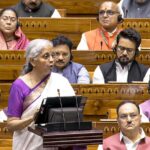The Balancing Act: Tax Cuts vs. Development Needs
The Indian government treads a tightrope between promoting economic growth through tax cuts and generating revenue to fund essential expenditures. Let’s delve deeper into the factors influencing this balancing act:High Expenditure Needs
- Infrastructure Development: India requires substantial investments in infrastructure like roads, bridges, and power grids to improve connectivity and support economic activity. Reducing taxes might necessitate cuts in infrastructure spending, hindering long-term growth.
- Defense System and Social Welfare Schemes: India spends significantly on defense to safeguard its borders and social welfare schemes to uplift vulnerable sections of society. Lower tax revenue could lead to reductions in these areas, impacting national security and social safety nets.
- Space Research Advancement: India prioritizes space research to compete globally in technological innovation. Tax cuts could lead to reduced funding for space programs, potentially hindering scientific progress.
Limited Tax Base and Low Tax-to-GDP Ratio - Narrow Tax Base: Compared to developed nations, India’s tax base – the population that pays income tax – is narrow. This means a smaller portion of the population contributes to the tax pool, limiting the government’s ability to reduce tax rates without significantly impacting revenue.
- Low Tax-to-GDP Ratio: India’s tax-to-GDP ratio, which measures tax revenue as a percentage of GDP, is lower than in many developed economies. This indicates that the government collects less tax revenue relative to the size of the economy, making tax cuts challenging.
Tax Compliance Issues - Widespread Tax Evasion: A significant portion of the Indian population remains outside the formal tax net, resulting in lost revenue. Addressing tax evasion is crucial to increase tax collection and reduce the burden on existing taxpayers.
- Informal Sector Challenges: The vast informal sector in India poses a challenge for tax collection due to the difficulty of tracking income and enforcing tax regulations.
Potential Consequences of Tax Cuts - Reduced Government Spending: Lower tax revenue could lead to cuts in public services like healthcare, education, and infrastructure development. This could negatively impact the quality of life for citizens and hinder economic growth in the long run.
- Increased Fiscal Deficit: A wider gap between government spending and income (fiscal deficit) could result in higher borrowing and inflation. This could lead to economic instability and erode the purchasing power of Indian citizens.
Taxpayer Statistics in India - Low Proportion of Income Tax Payers: Only a small percentage of Indians pay income tax, placing the burden on a limited pool of taxpayers.
- Unequal Tax Distribution: The tax burden in India is often considered unequal, with higher-income earners paying a larger share of income taxes.
To expand the income tax base in India, including wealthy farmers, several revolutionary steps can be proposed:
Suggested Steps to Expand Income Tax Base - Revising Income Tax Slabs: Introduce a new tax slab for higher income brackets, particularly targeting individuals earning above ₹15 lakh annually, with increased rates. This could help capture a larger share of wealth from high earners, including affluent farmers.
- Inclusion of Agricultural Income: Currently, agricultural income is exempt from tax. A threshold could be established where agricultural income above a certain limit (e.g., ₹10 lakh) is taxed. This would ensure that wealthy farmers contribute to the tax system.
- Taxation on Wealth and Assets: Implement a wealth tax on individuals with net assets exceeding a specified threshold. This could include real estate, luxury items, and investments, thereby diversifying the tax base beyond just income.
- Simplifying Tax Compliance: Streamline the tax filing process for individuals, particularly for those in agriculture, to encourage compliance. This could involve digital platforms that facilitate easy reporting of income and expenses.
- Public Awareness Campaigns: Launch initiatives to educate citizens on the importance of tax contributions and the benefits of a broader tax base for national development. This could help foster a culture of tax compliance.
- Incentives for Tax Compliance: Provide incentives for timely tax payments, such as discounts or rebates for individuals who consistently file and pay taxes on time, encouraging more people to enter the tax system.
Contribution of Citizens Towards Income Tax in Developed Countries vs. India.
In developed countries, income tax compliance is generally higher due to a combination of factors such as lower tax evasion rates, robust enforcement mechanisms, and a culture of civic responsibility. For instance, countries like Sweden and Denmark have high tax-to-GDP ratios, often exceeding 40%, with citizens recognizing the direct benefits of taxes in public services like healthcare and education.
In contrast, India’s tax-to-GDP ratio is around 11-12%, indicating a significant gap in tax contributions. This disparity can be attributed to a large informal economy, widespread tax evasion, and a lack of awareness about the benefits of tax compliance. Expanding the tax base in India could help improve public services and infrastructure, similar to the outcomes seen in developed nations.
Benefits of a Cashless Economy.
Transitioning to a cashless economy can significantly benefit the Indian economy in several ways: - Increased Tax Compliance: Digital transactions create a traceable record, making it harder for individuals and businesses to evade taxes. This could lead to an increase in the tax base as more transactions are reported.
- Reduction in Black Money: A cashless system limits the ability to conduct unreported transactions, thereby reducing the circulation of black money. This can enhance government revenues and improve economic transparency.
- Efficiency in Transactions: Cashless payments streamline transactions, reducing costs associated with handling cash. This efficiency can boost economic activity and growth.
- Financial Inclusion: A cashless economy encourages the use of banking services, promoting financial inclusion among previously unbanked populations. This can lead to increased savings and investment in the economy.
- Enhanced Government Revenue: With better tracking of economic activities, the government can more effectively levy taxes, leading to increased revenue that can be reinvested into public services and infrastructure.
These steps, along with the benefits of a cashless economy, can help India enhance its income tax base and improve overall economic health.
Conclusion
The Indian government’s tax reduction strategy involves a complex interplay between revenue generation and development goals. While tax cuts can stimulate the economy, they must be implemented alongside measures to improve tax collection, broaden the tax base, and address tax evasion. A well-balanced approach is crucial to ensure sustainable economic growth and improve the well-being of Indian citizens.
I hope this article is helpful! Do post a comment with your thoughts.












